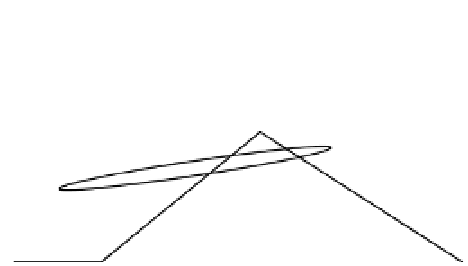Game Development Reference
In-Depth Information
The Physics of a Wave
Most ocean waves are caused by wind, although a ship traveling through the water can also
cause waves. A wave caused by a storm in the middle of the Pacific or Atlantic oceans can travel
hundreds or even thousands of miles before hitting the shore. The velocity of a wave when it
hits the shore is a function of the size of the wave. A typical wave velocity is 6
knots
or about 3.1
m/s
.
When the wave reaches shallow water, the water that is carried along with the wave begins
to interact with the bottom of the ocean. Friction between the water and the ocean floor causes
the water at the bottom of the wave to slow down while the water at the top of the wave main-
tains its velocity. The result is that the wave begins to steepen. The velocity mismatch between
the water at the top of the wave eventually reaches a point where the wave
breaks
and falls over
on top of itself.
Some waves seem to break everywhere at once. This type of wave is called a
close-out
and
is not ideal for surfing. The best waves for surfing are those where the break begins at one point
and then the break continues sequentially in one direction or sometimes both. This type of
wave can be ridden sideways, and the surfer typically tries to stay just ahead of the break point.
Catching a Wave
The critical element in catching a wave is to gather speed by paddling so the velocity of the
surfboard is fairly close to the velocity of the wave. If this is done, the wave will “pick up” the
surfboard and carry it along at the velocity of the wave. The force diagram of a surfer at the
point of catching a wave is shown in Figure 9-15. When the surfer catches the wave, the nose of
the surfboard is tipped downwards. Since the buoyancy force now acts at an angle from the
vertical, a net forward force is generated that accelerates the surfer to the velocity of the wave.
Figure 9-15.
When a surfer catches a wave, a net force pushes the surfboard forward.
When the surfer catches a wave, she is essentially standing on top of a hill of water. If the
surfer moves forward on the board, the board will speed up and slide down the slope of the
wave. If the surfer slows down the board by moving her weight back or by turning, the wave will
catch up to the surfer, and the board will climb back up the wave slope.
Turning
A surfboard is turned very much like a skateboard or snowboard is turned. To turn a surfboard
to the right, a surfer shifts his weight back and to the right. This causes the board to rotate onto













